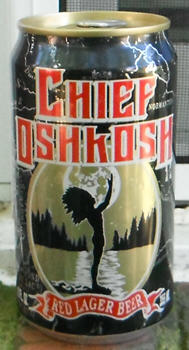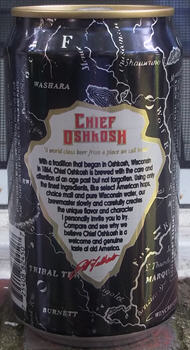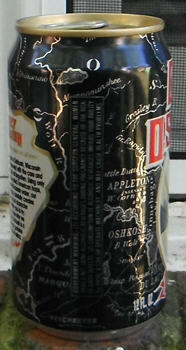Chief Oshkosh: 1991
 |
 |
 |
This month's can is a Chief Oshkosh from Wisconsin. It doesn't fit my usual collection criteria, but I wanted to feature it because it illustrates the problems small start-up breweries faced before the mass number of recent craft breweries came onto the scene. It's a bit of a transitional can between the domination of the big nationals and the recent micro revolution. (The can also won the 1992 Can of the Year Award for US cans from the BCCA.)
Chief Oshkosh
This brand had its roots in Wisconsin. Oshkosh had numerous breweries dating back to the 1830s. Wisconsin was a natural home for breweries in no small part because of its large German population. Milwaukee became the center of the state's largest breweries, such as Schlitz and Miller, but Oshkosh also had its share, including the Oshkosh Brewing Company, founded in 1894 when three of the city's largest breweries merged. A lot of breweries merged in the late 19th century often because British investors purchased groups of breweries in a single location, and then merged them (see my Frank Jones page for an example). Sometimes a city's breweries would merge to form a larger company to fight against the prohibition movement. (See my Dayton, Ohio brewing story). For the Oshkosh breweries, the merger was apparently to help them compete with Pabst and Schlitz and others from Milwaukee.
One of the Oshkosh Brewery's flagship brands was Chief Oshkosh, which featured a native American in full headdress on the label. The brand disappeared when the Oshkosh Brewing Company folded in 1971. The local People's Brewing Company briefly tried to keep the brand going, but it too closed, in 1972.
Mid-Coast Brewing
A local college student at the University of Wisconsin-Oshkosh in the early 1970s, Jeff Fulbright, began to think about reviving the brand. (You can find a more detailed version of the story at the Oshkosh Beer site. Fulbright attended the Siebel Institute, which has been training brewers since 1872, and developed a recipe for a red lager while he was there.
Fulbright did what a lot of begriming brewers did at the time, and what some still do, he went to an established brewery to make the beer using his formula. "Contract brewing" has existed for many years. It was often used to make private labels, usually a brand of beer that would be sold by a particular store or chain. I've discussed some of these brands in the past, such as Brown Derby, which was made for Safeway. Tudor Ale and Beer was made by different breweries for A&P groceries.
In 1990 Fulbright founded the Mid-Coast Brewing company, and arranged for Stevens Point brewery in Wisconsin to make his beer. Stevens Point was one of the few small local breweries that was still operating, although they were struggling. Contract brewing allowed them to use their brewery's full capacity. The first batch of Chief Oshkosh Red Lager was released in June, 1991.
Cans
So far the Mid-Coast story follows a very familiar pattern. A new brewer develops his own beer, founds a small company, finds someone to brew his beer, and goes into business. A few succeed, many did not. But Fulbright did something different that inspired me to chose his can as my Can-of-the-Month. he used cans. With the recent dramatic growth in canned micro-beers this may not seem like a big thing, but it was very unusual in 1991.
Cans were commonly viewed as being a lesser container for beer than bottles. Part of this was because metal can negatively affect beer, a problem can companies had to overcome when beer cans first arrived on the market in 1935. Some people claim that sipping beer from a can also distorts the beer's taste as their lips touch the can's metal. Cans also seemed somewhat declass compared to bottles. Cans were appropriate for cheap beer sold in bulk to people who just wanted a cheap drunk, but bottles were better for the beer and, therefore, marked a better type of consumer.
Fulbright argued in his beer ads that cans were better than bottles for several reasons...
1. Light damages beer and cans protected beer from light better than even dark brown glass bottles.
2. Most cans were recycled.
3. Cans take less energy and resources to produce than bottles.
4. Cans were cheaper and so kept retail costs down.
Many of Fulbright's arguments are used today by the new micro-brewers. See, for example, the website of the Michigan Mobile Canning company, that cans beer for micro-brewers.
Closing Shop
The new Chief Oshkosh did sell, at least for while. It got good reviews from beer aficionado magazines, and won a silver medal at the 1994 World Beer Championships in Chicago, the first year they were held. Fulbright began making arrangements to sell his beer throughout a much larger region. Unfortunately, other breweries began coming out with red lagers, most notably Leinenkugel Brewing, owned by giant Miller Brewing, which came out with its own version in 1993. The other giants followed: Coors' Killian's Red, AB's Elk Mountain, Labatt's Elephant Red, and so on. Some succeeded and some brands disappeared quickly. Other smaller brewers also made their own "red" beers as well, such as Pete's Wicked Red.
With the market flooding with other red beers, distributors lost interests in helping Mid-Coast expand their market. In late 1994 Fulbright ran out of capital. The last batch of Chief Oshkosh Red Lager was produced in late 1994, and sold in 1995.
The Chief Oshkosh can is not rare, although it's not especially common either. In the early 1990s can collecting was in a lull period and few collectors spent a lot of effort saving new aluminum cans at the time. They are available though. Fulbright's idea was ahead of its time, and his Chief Oshkosh may well have been the first micro-brewed craft beer in cans.
Sources Used
Akin, Ron. "The Rise and Fall of the Oshkosh Brewing Company" The Breweriana Collector. 81 (Spring 1993). 9-12.
Oshkosh Beer Blog. (accessed November 7, 2013)
"The Better Red" Suds 'n Stuff. 10/5 (September/October 1993). 12.
Reiherzer, Lee. "Chief Oshkosh Red Lager: A Can Ahead of Its Time" Beer Cans and Brewery Collectables. 4/43 (August/September 2013). 14-16.
Robertson, James D. "Red Beer" Suds 'n Stuff. 13/4 (July/August 1995). 1.
